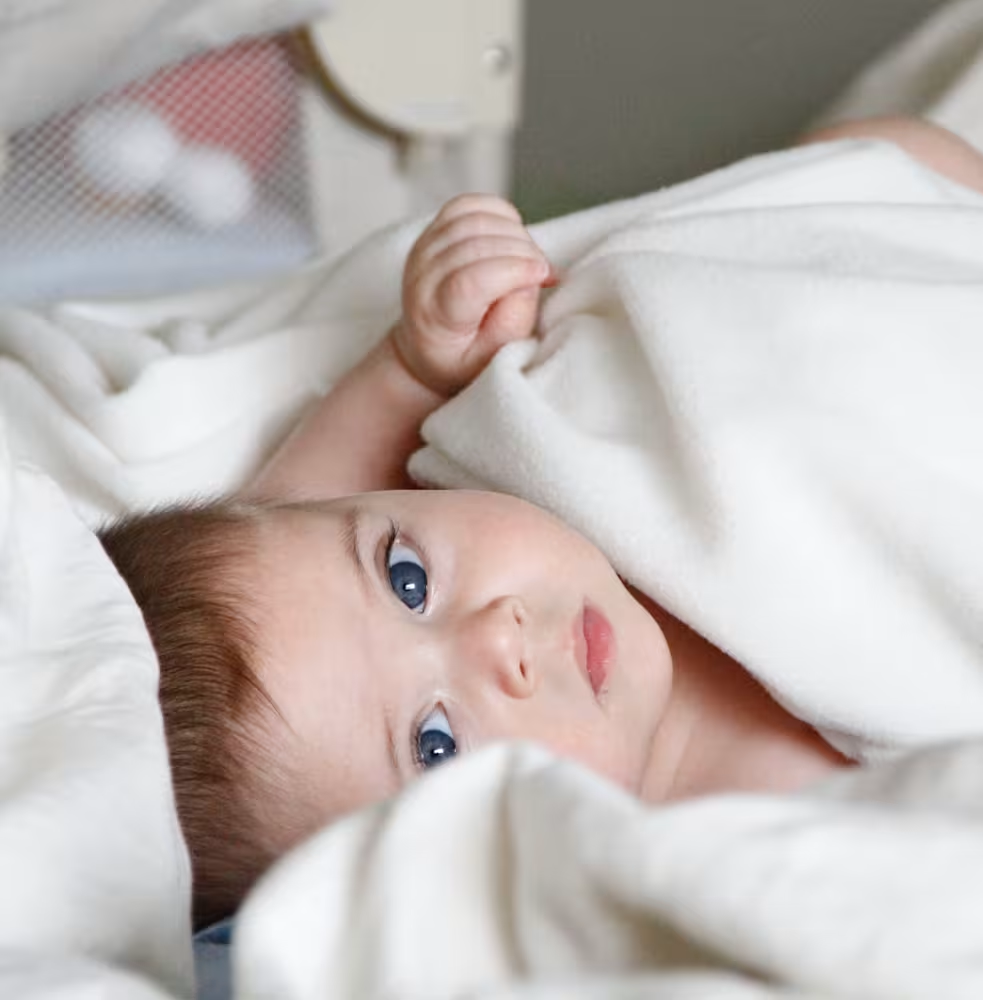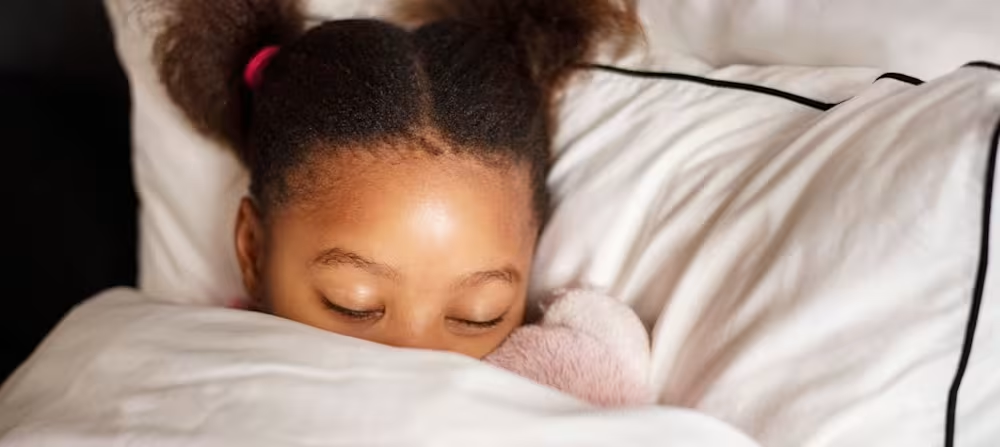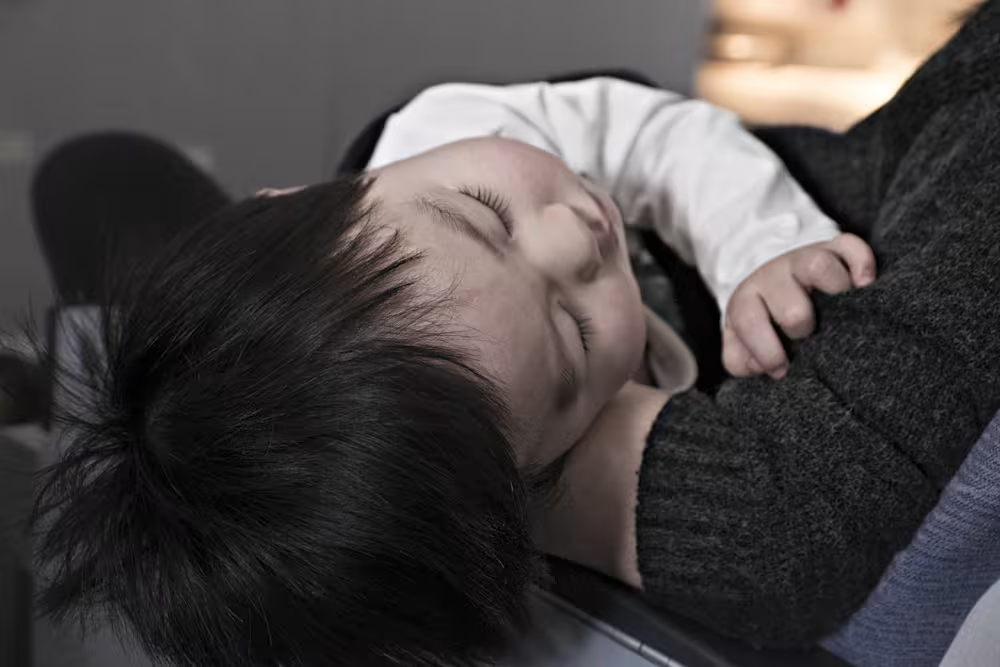How to handle toddlers climbing out of the crib
Updated Oct 16, 2025

You likely won’t forget the first time you glance at the baby monitor and see your toddler attempt to shimmy their little leg over their crib rail or even successfully climb out. Watching your little one achieve new milestones is often exhilarating for parents, but it can feel scary when their development comes with newfound physical capabilities and a desire for independence.
When your child becomes an escape artist, it brings new safety considerations to your bedtime routine and your child's sleep space. According to the American Academy of Pediatrics (AAP) [], falls are the most common crib injury. Thankfully, they’re usually preventable, especially if you can determine the potential reasons behind crib climbing and then what you can do to discourage it. Ultimately, the goal is to help your child get the sleep they need while staying safe, whether remaining in their crib or transitioning to a bed if the time is right (for them and you!).
Understanding why toddlers climb out of cribs
If your toddler has started climbing out of their crib, one (or more!) of the following factors may be at play:
Developmental milestones
Physical growth and increased mobility
As your little one grows taller and stronger, moving around (and trying to get out of) their crib becomes physically easier. After learning new skills, like pulling to stand and climbing, mini-movers are usually eager to practice what they’ve learned — on the side of their crib when they should be sleeping. It’s common for temporarily when children are working on a new physical milestone.
Curiosity and independence
Yes, your kiddos are interested in learning new skills and are also typically increasingly curious [] about the world around them. As toddlers develop, they become even more aware of their environment, like all the fun things in their room — just outside their crib. At the same time, children also realize they're capable of getting to where they want to go. This newfound independence and increased curiosity make for a peak interest in exploring instead of sleeping, which can lead to climbing out of the crib.
Emotional factors
While kiddos settle into toddlerhood, they don't just seek independence; they also begin testing boundaries. Part of this is exploring new ideas and their physical abilities, but another part is trying to get your attention. They may be over this whole sleep idea and want you for playtime. Or, as their imagination peaks, so can new, and they need your comfort. Either way, the bottom line is they want to be close to you — physically and emotionally. Your clever crib climber may then work on getting out of their crib as a way to get to you (or get you to come running!).
Separation anxiety
is a normal part of development in babies and toddlers that often comes in waves. Typically, it begins around 8 - 14 months [] before decreasing around. It usually hits again around. During these phases, your child might feel clingier than usual and have a harder time being separated from a caregiver. This can cause bedtime difficulties because your child may refuse to lie down or stay in their crib. They may altogether.
Discomfort
Physical discomfort like teething pain, illness, or a wet diaper may make it harder for your toddler to fall asleep and stay asleep. They may seek you for comfort and use that newfound independence to try and get to you.
Sleep environment factors
Crib design
Your child will eventually hit this major milestone: . Being too tall for the crib design makes it easier for them to hike a leg over the rail and climb on down. According to the AAP [], little ones are ready to transition out of the crib once they're 35 inches tall, typically between 18 - 24 months. However, note that transitioning away from the crib before 3 years of age can lead to new sleep challenges. Many kiddos never try to escape the crib and some parents prefer to hold off on a big kid bed until closer to 3 despite the potential safety risks.
Safety concerns surrounding climbing out of the crib
Risk of injury
Climbing out of the crib is dangerous for little ones. According to the AAP [], falls are the most common injury associated with cribs, and most falls occur when a baby tries to climb out. To help prevent this, the AAP suggests transitioning your child to a once they are 35 inches tall or when the side rail is about chest level.
If your little one starts trying to escape their crib, falling during the climb isn't the only safety risk to consider. Their room can pose additional dangers if they manage to climb out, and your should be evaluated (and potentially upgraded). Ensure all heavy furniture is anchored to the wall and any cords from window treatments or monitors are out of reach. Although not all children ever attempt to escape, aim to ensure your child is in a safe sleep environment in case they unexpectedly go for it before transitioning to a bed.
If your child seems content in their crib, it's important to weigh the safety risks of falling out as well as other potential dangers. Kids who move to a big bed before the age of 3 may not have the impulse control to stay in bed at night, leading to disrupted sleep. More importantly, transitioning too early could give them unsupervised access to areas of the house, like stairs or the kitchen, which pose safety hazards. Make sure your child is ready for the transition, and consider using safeguards like gates or childproofing to minimize risks.
How to ensure a safe sleep space
Here’s what the AAP [] wants you to know about crib safety tips and making your baby’s room safe for crib climbers:
Check that the mattress height is correct. Children are most likely to fall when the crib mattress is too high. Stay ahead of developmental milestones and lower the mattress before your baby learns to sit. You’ll also want to make sure it’s moved to the lowest position before they can stand.
Ensure no strings, cords, or any other strangulation hazards are dangling anywhere near the crib.
Only use a crib made after June 2011 (when safety standards banned drop-side rails).
Ensure all hardware is from the original manufacturer and is tight (especially after mattress height adjustments).
Move your child to a bed when they are 35 inches tall or when the side rail reaches their chest. Note that it’s common for toddlers to develop new sleep challenges when they make the transition before 3 years of age.
Place your baby’s crib (and eventually bed) away from any windows. This helps prevent falls and getting caught in dangerous cords from window blinds or curtains.
Other tips for creating a when dealing with climbing toddlers include:
Move any furniture that’s next to the crib (like a dresser or bookcase), so your little one can’t use it to help them climb out of the crib.
Consider moving the crib away from the wall — your child could also use it to help scale their way up the rail.
Clear the crib of everything (think toys or thick pillows); your clever toddler could use these items to stand or prop themselves up to climb over the rail.
Tips to help prevent crib escapes
Crib climbing is dangerous for kiddos and can be stressful for parents, but these strategies may help your toddler safely stay in their crib:
Adjust the crib mattress
Try using a sleep sack
Move the crib
Check their sleep schedule
Offer extra support before sleep
Find more details below:
Tip #1: Adjust the crib mattress
Although falls are the most common injury from cribs, they often can be easily avoided. Check the position of your toddler's mattress and adjust it to the lowest appropriate setting before your child achieves various developmental milestones. Lower the crib mattress before your baby learns to sit, and move it again to its lowest position before your child starts to stand. This helps prevent your little one from falling while leaning over the rail or pulling themselves over it.
Tip #2: Try using a sleep sack
If you have a mini escape artist on your hands, a can be a crib-climbing solution. These wearable blankets contain kiddos’ legs, making it harder for them to get a leg free and hoist over the crib rail.
Tip #3: Move the crib
Your toddler’s crib position can impact how easy it is for them to climb out. If their crib is designed with a lower front and higher back, try flipping it. Rotating the crib so the taller rail side is in front can make it harder for little ones to get themselves over the side. However, check to see if your child is then using the wall as leverage to shimmy their way up. You may also consider moving the crib away from the wall (or any other nearby furniture).
Tip #4: Check their sleep schedule
When bedtime is too early or wake windows before naps aren’t long enough, kiddos don’t have enough sleep pressure [] (tiredness) built up to fall asleep. They may start exploring to cure their boredom. If your toddler is and trying to climb out of their crib instead, these toddler sleep issues may signal the need for a schedule adjustment.
From to, most children go from needing around 4 hours to as much as 6 hours of awake time to be tired enough to sleep. Toddlers also typically drop to between 14 - 18 months.
Tip #5: Offer extra support before sleep
It's common for toddlers to go through waves of and suddenly want their parents to stay with them at bedtime. During these clingy stages, your toddler may have trouble falling asleep without you and try to take matters into their own hands. To help reassure your child as they learn that you'll always come back, consider including some extra cuddles during their bedtime routine. Aim to keep sleep routines for toddlers as consistent as possible, but adding some extra affection can help make your child feel confident and secure before bedtime.
When to transition to a toddler bed
The AAP suggests transitioning out of the crib once your little one is 35 inches tall (which typically happens between 18 - 24 months). However, if your kiddo is content in their crib and isn’t making escape attempts, we find that the transition goes much more smoothly if parents wait until closer to 3 years of age.
Most toddlers under 3 years of age don’t have the impulse control developed to stay alone in an unenclosed sleep space (like their bed instead of a crib). This makes the transition to a big kid bed especially challenging for them. It may take extra consistency and time for a .
If you want help transitioning your child from a crib to a bed, consider requesting a Sleep Plan through . Our sleep experts can provide you with a step-by-step customized plan that accounts for your child’s age and your parenting preferences.
Signs your child is ready for a crib-to-bed transition
It might be time to move from the crib to a bed if your child has:
Started climbing out (or trying to climb out) of their crib
Reached 35 inches tall
Become cramped in the crib and a bed would be more comfortable
Shown they’re able to understand the meaning of external visual cues
Responded to bedtime boundaries you set
Expressed interest in a big kid bed
Signs your toddler isn’t ready for a toddler bed transition
You might want to wait a bit longer before transitioning if:
Your child is under 3 years of age
Your toddler is not about 35 inches tall, and the rail isn't chest-level
Your child is not showing signs of climbing
Your child is content in their crib
Takeaway
Falls are the most common crib injury but are often avoidable.
It’s normal for toddlers to try to climb out of their crib. Developmental, emotional, and physical factors can all play a role in your little one turning into a crib climber.
The AAP suggests moving your child to a toddler or "big kid bed" when they are 35 inches tall. However, this transition can be harder for kids under 3 years old with underdeveloped impulse control.
To help discourage your child from climbing out of their crib, you can try lowering the crib mattress height, using a sleep sack, moving the crib, adjusting their sleep schedule, setting boundaries, and offering extra cuddles before bed.
Toddlers climbing out of crib FAQ
Share article:
Note: The content on this site is for informational purposes only and should not replace medical advice from your doctor, pediatrician, or medical professional. If you have questions or concerns, you should contact a medical professional.





